Jenny Holzer covers the world with poetry.
Holzer, a conceptual artist from New York, projects words and ideas on the sides of rugged mountains, across sprawling deserts and on top of rippling bodies of water.
On Tuesday, Holzer will be in Portland for a site-specific projection of the words of Nobel Prize-winning poet Wislawa Szymborska on the exterior brick wall of the Portland Museum of Art at Congress Square. She is calling her temporary installation “For Portland.”
“We will see big letters of great poems in brick,” Holzer said by phone. “Not only can I show poetry, but it feels poetic when you see this pretty white light flowing inexorably.”
Her work in Portland is in conjunction with a lecture Holzer will deliver at 6 p.m. Tuesday at Holiday Inn by the Bay on Spring Street. The projection will commence at 7 p.m. and continue until 10 p.m.
The program marks the 10th anniversary of the Nelson Social Justice Fund at the museum. The fund honors artists whose commitment to social justice is manifested in their work.
Holzer’s presence in Portland is a big deal. She is a widely celebrated artist, and was the first woman to represent the United States at the Venice Biennale.
Portland is among the smallest cities where she has created projections. Her previous venues include the Reichstag in Berlin, which houses the German Parliament, the Guggenheim museums in New York and Bilboa, Spain, and the prestigious biannual Venice exhibition. She projects on modern skyscrapers of capitalism and ancient tombs of history.
Holzer began her career three decades ago as a street artist working with posters. Over the years, she has incorporated electronic signs and LED lights into her work. “For Portland” will involve traditional projections on a flat, textured surface.
Holzer, who has worked outdoors since the 1970s, treats unpredictable weather as part of her artistic challenge and reward. She confronts many surprises, most of them good and some occasionally bad.
A dust storm in Mexico delighted her because “the particulate matter let you see the words as they marched out of the projectors. On the other hand, moderate to heavy fog is bad. It dims the projections. But tremendously awful fog makes a great screen.”
She’s eager to arrive at the museum. Google Earth enables Holzer and her team to do practical advance work about a building or projection site. She knows what the museum looks like, the shape of Congress Square and the configuration of nearby buildings.
But until she actually sees the building and is close enough to touch it, she won’t appreciate the full spectrum of her opportunity.
“The site matters a lot,” Holzer said. “The reason projections are different in each place (is because) the screen, be it a building, a lake or a river, is important. The cool thing about projections, they highlight not only the form of the building, but they shine a light on the material or materials of a building as well.”
Ohio born, Holzer began her career as a painter and printmaker, and shifted to working with projected words and text as her medium when she moved to New York in the mid-’70s.
At first, she wrote most of her own texts, but gradually began incorporating the words of famous writers. In addition to using the poetry of Polish Nobel laureate Szymborska, she borrows the words of Iraqi writer Fadhil Al-Azawi, Israeli writer Yehuda Amichai and others.
She has projected excerpts from declassified military documents, and her work often touches on issues of violence, oppression and injustice.
Her work, she said, is about exposing things that are meant to be hidden. What better medium than the written word to educate and enlighten?
“Words are a powerful means of expression, period,” she said. “I’ve been using Szymborska’s poetry for some time now, and am continually grateful to have it. She treats any number of tough subjects in an intelligent, measured and feeling way, which is no small feat.”
Holzer attended Ohio University, Rhode Island School of Design and the Independent Study Program at the Whitney Museum of American Art. She received the Leone d’Oro at the Venice Biennale in 1990 and the Public Art Network Award in 2004.
While Tuesday’s projection will be her first in Maine, her journey north will not be her first trip to Maine.
“I’ve been to Maine a couple of times. I spent a week there this summer, and I am a convert,” she said. “I understand why people flock to Maine.”
Staff Writer Bob Keyes can be contacted at 791-6457 or at: bkyes@pressherald.com
Follow him at Twitter at: Twitter.com/pphbkeyes
Send questions/comments to the editors.


